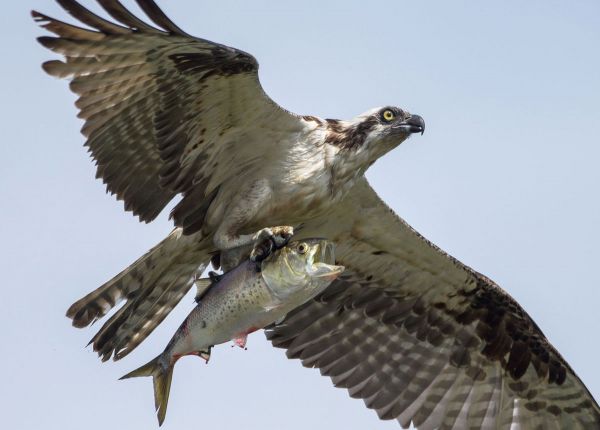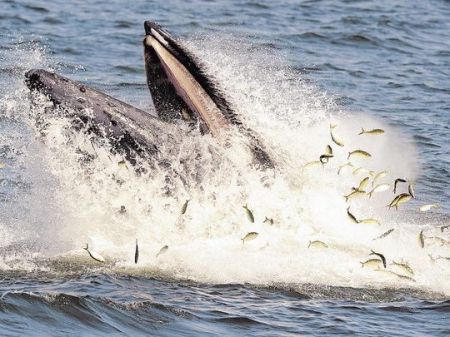Healthy U.S. marine fisheries rely on management plans approved by government stewards that keep prized fish in the water and people in business. It mostly works for the saltwater stars such as striped bass, bluefish, and snappers but not as well for forage fish like menhaden, according to scientists, conservationists, and a variety of stakeholders.
On Nov. 13-14, the Atlantic States Marine Fisheries Commission will vote on Amendment 3 to its menhaden management plan, a potentially landmark conservation decision that acknowledges little forage fishes as major players in the ocean’s ecosystem.
 “The ASMFC can build on advances around the world and make history by applying the best ecosystem-based approach to the largest fishery on the U.S. East Coast and one of the biggest on the planet,” said Joseph Gordon, senior manager for mid-Atlantic conservation issues for the Pew Charitable Trusts.
“The ASMFC can build on advances around the world and make history by applying the best ecosystem-based approach to the largest fishery on the U.S. East Coast and one of the biggest on the planet,” said Joseph Gordon, senior manager for mid-Atlantic conservation issues for the Pew Charitable Trusts.
Menhaden, aka bunker, school in hundreds, often thousands, and are almost humanly inedible. They range north as far Nova Scotia and south into Florida and are a vital food source for osprey, bald eagles, dolphins and seals. The protein-packed commercial value of bunker includes fertilizer, fish oil products, pet food, and cosmetics. And as bait.
“Their primary role in the ecosystem is to serve as prey for other marine species,” Gordon said this week in an email exchange. “For that reason, scientists increasingly agree that forage fish like menhaden should be viewed from an ecosystem perspective.”
 » 5=Q&A with Joseph Gordon
» 5=Q&A with Joseph Gordon
» Related: “These fish have been overlooked, largely for decades, in terms of fisheries management.”
In Amendment 3, the ASMFC, a panel of state fisheries bosses that regulates catches of migratory fishes from coastlines to 3 miles offshore, identifies multiple pressures on menhaden and proposes using "ecological reference points" as a tool to determine sustainability.
"While [fisheries] managers use reference points to set catch limits, they are not using ecological reference points yet," Gordon said.
According to a single-species calculation by NOAA, menhaden are plentiful. But Gordon says the stock data only reflects the ability of the commercial menhaden harvest to avoid depletion, not its capacity to provide adequate forage for other species in the ecosystem.
“The right question is: are there enough in the ocean to adequately feed predators and sustain other fisheries?" Gordon said. "From this perspective, there may not be enough menhaden. A number of their Atlantic predators are in decline in part because of lack of food, and menhaden are no longer abundant through their full historic range. Southern states like Florida have not enjoyed the benefits of a recovery.”
Florida's cut of the East Coast-wide bunker quota is 78,449 pounds: .02 percent of the overall 2017 quota of 440,924,524 pounds, according to Gordon. But Florida’s leadership where forage fish are concerned has been large, Gordon said.
“The Florida Fish and Wildlife Conservation Commission, which has a representative on the ASMFC, has been a leader in forage fish management,” Gordon said.
Also:
● Fifty stakeholders attended an ASMFC hearing in Melbourne Oct. 10 and 69 of 182 Atlantic Coast marine businesses and organizations that expressed support for Amendment 3 in writing are based in Florida, including charter fishing captains, sportfishing groups, scuba diving companies and clubs, conservation organizations, and eco-tourism operators.
● Support includes 17 Florida scientists who added their reputations to a national letter of support for ecosystem-based conservation.
The ASMFC manages 27 fishes and some stakeholders call menhaden the most important. For sure, menhaden doesn't get the lemon juices flowing like, say, red snapper, which regularly and fiercely pits commercial and many recreational fishers against state and federal overseers.
According to Gordon, Amendment 3 can ensure that all menhaden predators — from fish to birds to marine mammals and commercial fisheries — have a seat at supper table.
“If the ASMFC … moves forward with a modern approach to managing menhaden, Floridians will see menhaden increasing in the waters off our shores. The benefits would be both economic and environmental for Florida – a healthier marine ecosystem that provides us with better fishing, diving, birding, and with growth in tourism that would follow that.”
» Photos (top) via Shoreline Times / Kristofer Rowe; NJ.com / Tyson Trish.
Outside
Bitcoin mining emissions in China will hit 130 million tonnes by 2024 https://t.co/w6He7so8N2 pic.twitter.com/qYUDtBdeRK
— New Scientist (@newscientist) April 9, 2021
The Gunk Report
For the Blue-Green Algal Bloom Weekly Update from the Florida Department of Environmental Protection, tap here. For DEP's Algal Bloom Sampling Map, tap here.
What, me worry?
» "PLAYING WITH SHARKS," which recently premiered at the Sundance Film Festival, documents diving legend Valerie Taylor.